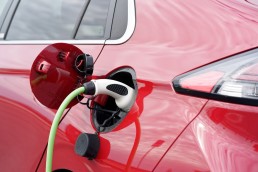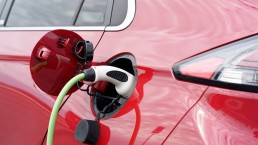Digital acceleration of CN0 planning in Transport Infrastructure
Challenge
The Infrastructure and Transport sectors play a critical role in the UK’s overall Net-Zero ambitions. The infrastructure industry controls 13% of the UK’s total carbon emissions and influences a further 37%.
55% of the UK’s carbon emissions comes from the usage of transport infrastructure. Transport is the UK’s worst-performing sector for carbon reduction, and the only sector where greenhouse gas emissions are increasing.
Our client intends to reduce its carbon emissions and support the government’s ambition to achieve Net Zero carbon emissions by 2050. However, it’s investment strategy for the coming years is currently incompatible with its legal obligation to reduce its carbon. With the siloed nature of current Initiatives on capturing, measuring & reporting not being effectively geared towards carbon reduction, the introduction of some accelerators was necessary.
Curzon's approach
Curzon understands that Innovation, Digital capability and Data will play a critical role in carbon reduction. Our focus was on accelerating to Net Zero through Digital.
As part of this approach, we sought to ground future Net-Zero plans in reality. One of the most prominent challenges faced by our client’s business (and the wider industry) is efficiency across the asset management lifecycle. We took a deeper look into the digital enablement of productivity.
There is an entire spectrum of on-site productivity management capability areas that can be enhanced through the new or improved application of digital tools. Prioritisation and deployment decisions are driven by functional capability assessments and a multi-dimensional review of each tool’s benefits, use in increasing on-site productivity, deliverability and scalability. Moving forwards, tools can be identified/developed/assessed and their prioritisation should be influenced by what they offer from a carbon reduction perspective.

Impact
We identified a select number of productivity enabling digital tools that can be scaled to offer substantial heavy-duty vehicle performance, load management and fuel efficiency benefits that will have a significant carbon reduction impact.
Contact our Sustainability service line lead,Andrew Wilson, to find out more
related articles
Cost-carbon reduction in Utilities and Property Development
Challenge
Successfully delivering infrastructure associated with water supply and property development growth are two of the most critical features of the UK’s socio-economic landscape. Our client serves the fastest growing area of the country in terms of home building; one in five new homes built in the UK are connected to its network and over 200,000 new homes will be connected in the next 5 years. This will require water infrastructure costing c.£350m.
The business identified recurring sub optimal performance in service delivery to developers and capital expenditure efficiency. Against a backdrop of historic performance failures the ambition was set for the business to be recognised as a true enabler of environmentally sustainable property development growth.
Curzon's approach
Through helping to build a digital business case, sharpen the project strategy and support the organisation in effecting new ways of working, Curzon guided the business in creating a bespoke system.
The system fully digitises the planning and asset delivery processes whilst providing advanced geospatial capabilities. This enables the identification of site cluster for the most efficient, collaborative approach to infrastructure delivery as well as optimum timing on the phasing of infrastructure build activity to align with developer phasing plans.
Curzon identified a number of No Build Solutions (avoiding need to build with early developer engagement) and Low Build Solutions (influencing developer design with early engagement).
In addition, we evaluated commercially and technically innovative alternative water partnership opportunities.

Impact
The client now has the capability to take a strategic approach to asset planning across the entirety of a water resource zone and recycling catchment area, reducing emissions from construction and reducing design costs by identifying site clusters and efficient solution. Better site visibility provides greater insight on the needs of property developers, enabling sustainability initiatives such as water reuse to be encouraged and cutting the cost of late changes.
This transformation has placed the business on track to deliver c£32m or 9.2% in capital delivery savings over the next five years and 15% in operational efficiency.
Contact our Sustainability service line lead,Andrew Wilson, to find out more
related articles
Carbon net zero consensus vs the circular economy
Two core concepts behind carbon net-zero (CN0) are carbon reduction, which focuses on lowering negative greenhouse gas (GHG) emissions, and carbon offsetting, where negative emissions are counterbalanced through activity and investments that theoretically net-off their impact.
Policy and public consensus leave the impression that achieving ‘carbon neutrality’ or CN0 through this reduction and offsetting is the one (or two) stop-shop solution to addressing the world’s climate change and sustainability challenges. Perhaps a bit more constructive challenge to this consensus is required.
Up in the trees
The majority of carbon offsetting is conducted through reforestation or afforestation. There are other more esoteric activities such as targeted investments in developing nations that facilitate reduced GHG emissions, e.g. gifting fuel-efficient stoves to specific communities. However, at present there is particularly limited agreement on the timing of offsetting activities; organisations can theoretically report outcomes years ahead of their implementation.
About the author

Phil Hanson
More about the authorA guessing-game
Whilst meaningful calculations of CO2e emissions are plausible, arguably the calculation of carbon offset is a guessing game. Using reforestation and afforestation as examples: The lack of scientific consensus on the calculation of carbon capture, the finite lifetime of trees, failure to account for existing flora being displaced by trees being planted, the global-warming impact of light absorption by dark forests (especially in previously white, tundra regions) and the insulating impact of organic aerosols released by trees all serve as strong challenges to the generally accepted carbon-capture benefits.
The organisations promoting empirically precise carbon offsetting activities are inevitably motivated to deliver the most significant carbon-capture for a given cost, often driving them to plant fast-growing trees to generate the speediest carbon sinks. Studies, however, have shown that rapid tree growth directly correlates with short life-span, after which the dead tree is either decomposed naturally or burned. This releases the “captured” CO2 and accelerates the point at which carbon capture is permanently reversed. Careless tree-species selection creates further challenges around habitat preservation, for both flora and fauna, with major knock-on consequences for local ecosystems.
Even more fundamentally, the term CO2e may acknowledge the net warming effects of GHGs, but when it comes to carbon capture, it risks oversimplification. Photosynthesis captures CO2, but the remaining GHG groups including nitrous oxides, hydrofluorocarbons and chlorofluorocarbons are not part of the equation; they continue being generated and released unabated and ignored.
It’s all about timing
There are various accounting methods for assessing the impact of timing with respect to money: Discounted Cash Flow, Net Present Value and Internal Rate of Return, are calculations that recognise the importance of timing in financial decision-making. No such calculations exist for carbon offset: Organisations can produce GHGs today, and have a ten-year-plus plan for when these will be offset, without addressing the damage or reduced benefit of the delay. The urgency of action on sustainability is unquestionable, acknowledged but still not fully understood.
Regressive macro-behaviours
The prevalence of the CN0, Sustainability and ESG agenda certainly highlights a widely shared intention. However, albeit perhaps being deliberately extreme in reference points, some of the large-scale actions being marketed highlight branding exercises that deflect from the critical need for more fundamental change in our approach.
Take the whole concept of carbon credits as an example? It can be humorously (and dramatically) argued that these are reminiscent of the medieval Catholic practice of selling “indulgences”; a financial penalty to reduce the religious penance required by heaven for forgiveness. The wealthier you were, the lesser the repercussions for sinning!
However, their regressive macro-behaviours are no laughing matter. Reforestation for example typically takes place ‘behind closed-doors’ and this can have disastrous results. Since 2009, the Kenya Forest Service, backed by EU funding for reforestation, has been forcibly removing and dispossessing the Sengwer people of the Embobut Forest, burning more than 1500 homes in the process, and killing one Sengwer man. This humanitarian disaster, highlights just one facet of the overlooked, problematic underbelly of our approach to CN0.
The BBC and Greenpeace have run articles highlighting the level of waste being exported to Turkey, with estimates of 40% of UK plastic ending up there. In theory, this plastic is exported to be recycled, but the reality is that once those responsible have pocketed their payment, it is simply dumped. Simplistic recycling targets, and an acceptance of devolving accountability is at the root cause of these issues: The National Audit Office was damning in its findings stating in July 2018 that “[The UK’s recycling system] appears to have evolved into a comfortable way for government to meet targets without facing up to the underlying recycling issues. The government has no evidence that the system has encouraged companies to minimise packaging or make it easy to recycle. And it relies on exporting materials to other parts of the world without adequate checks to ensure this material is actually recycled, and without consideration of whether other countries will continue to accept it in the long term.”

Carbon offsetting opportunities are a finite resource
There is a limit to how much reforestation and afforestation can be conducted, both in terms of absolute capacity, or more challengingly, due to financial constraints. The largest and longest-lived type of commercially grown fauna is fruit trees (the largest major group being cherry trees) which typically grow no more than 15m tall, whereas as an example, most pine species consistently grow to 50m or more. Broadly speaking, the taller the tree, the denser the carbon capture for a given area. What this means is that optimal carbon-sink solutions have severely limited meaningful commercial benefit so the land must be procured for offsetting projects, and maintained at cost. At present, there are large swathes of suitable low-price land available, but as these options are exhausted by initial offsetting ventures future projects will have to procure land with commercial uses at much higher costs. Developed nations will likely purchase the majority if not all of the cheap land, leaving developing nations with few or no options available.
Used cooking oil is commonly re-purposed in the UK, burned as biodiesel in lorries, which once again, in isolation is a positive step. However, such is that the appetite for cooking oil derived biodiesel in the UK, that businesses have begun importing it from overseas. Burning marine diesel to transport cooking oil to be burned as biodiesel (which still emits GHGs) all to save on lorry diesel usage? This has a net detrimental environmental effect compared to burning biodiesel at or near its origin and raises obvious questions.
CN0: A single, over-simplified metric
Putting aside carbon off-setting practices, measuring CO2 emissions as the sole metric for success in the sustainability battle means that other negative consequences become fair game. Resource depletion, habitat destruction, loss of biodiversity, water pollution, water poverty and human suffering at times go unchecked. There is particular cause for concern around “green” technologies with a focus on energy generation and energy storage.
- Dependence on cobalt: At present, the highest energy-density commercially available batteries are lithium-ion (Li+) with cobalt-based cathodes and they form the mainstay of almost all consumer electronics where battery size and weight are critical selling points like phones and laptops. More than 55% of the world’s cobalt is mined in DR Congo, where Amnesty International estimate 40,000 child workers are at risk of contact dermatitis, Hard Metal Lung Disease, lethal mine collapses, atrocious working conditions and modern-day slavery.
- Lithium remains a problem: Manufacturers of larger applications of Li+ batteries such as battery-electric cars, have more recently been moving away from cobalt cathodes, such as Tesla in September 2020, but the lithium remains problematic. Lithium is found in three forms in the earth’s crust; in solution (brine) and two mineral formats (pegmatite and sedimentary). Lithium brine forms the majority of global reserves, and is predominantly found in low purity form of 4-6% in deep aquifers (subterranean water reserves) often underneath unique salt-flat habitats. Lithium brine is pumped onto vast plastic sheets to evaporate the water and leave behind lithium salt deposits. Extraction of mineral forms means mining, whilst purification requires sulphuric acid, releasing atmospheric CO2. Modelling by LUT and Augsburg universities suggest earth will exhaust its lithium reserves between 2040 and 2100 dependent upon battery technologies, battery electric vehicle (BEV) manufacturing, lithium recycling and global population variables. This modelling assumes the appetite to destroy virtually all of the world’s largest salt-flat ecosystems.
- Water: Water vapour is part of a positive environmental and atmospheric feedback loop. Unfortunately, due to some of the aforementioned CN0 related activities there are some serious ramifications for water on the horizon. Making full use of global lithium reserves requires (along with rock extraction) removal and evaporation of subterranean lithium brine. Much of this supply is in the form of non–meteoric aquifers; meaning they are not replenished during the course of the hydrologic (water) cycle, instead consisting purely of water formed by geological events early in the earth’s history, from evaporated seas and volcanic activity. These supplies are not renewable. Further still, this removal and evaporation causes the water tables to drop in the associated surrounding areas which has a resulting detrimental effect on wildlife, farming, etc. Lithium brine is typically found beneath evaporated sea-beds which are almost exclusively located in deserts with no viable alternative water source.
- Solar power comes at a price: At the core of solar-power (photovoltaic) technologies is high-purity silicon, extracted from quartz (silicon dioxide). Quartz is mined world-wide, with the greatest concentrations in developing nations, where labour conditions are poor and miners are exposed to carcinogenic respirable-sized quartz, responsible for the diseases silicosis and pulmonary fibrosis. Initial quartz purification requires heating with carbon (often using fossil-fuels) to 2000°C to remove the dioxide component, released as atmospheric CO2. Further purification uses hydrochloric acid, by-producing the incredibly toxic compound silicon tetrachloride, responsible for several environmental disasters in China. Construction of a large solar-power installation (200+ Megawatts) requires upwards of a billion litres of water, and can consume more than 20 million litres per year to keep it sufficiently clean.
- Wind-farms: Wind-farm turbine-blades are typically constructed from varying combinations of glass-fibre, polyester, epoxy and carbon-fibre, the sourcing and processing of which involves significant quantities of volatile organic compounds a class of environmental pollutant compounds hazardous to human health. They have a designed lifespan typically of 25 – 30 years, with first-generation wind-turbines now being decommissioned. In March 2021, New Civil Engineer published an article highlighting the CO2 reduction initiative of re-purposing worn-out wind turbine blades in lieu of steel rebar for construction concrete. Definitely innovative and any diversion from landfill or reduction of carbon is a success. However, as well as being clear on the implication of down-cycling in this manner it is important to seize upon the opportunity to push further and scale such initiatives. For example, contrasting wind-farm turbine blades with other turbine blade types highlights the opportunity for a more holistic approach: Aviation propellers have planned life-cycles, defined by flying hours, and are designed with erosion-shields and sacrificial high-wear parts made of readily-recycled steel and aluminium replaced at scheduled intervals to keep the blades operational, and prolong the lifecycle of the core components.
What to do?
Carbon reducing activities are and must remain a key focus for all. BEVs, sustainable aviation fuel (SAF), biodiesel all make the headlines, and the public are provided with easily accessible solutions like re-usable shopping bags and recycling whilst it seems that the real difficult changes are yet to come.
Perhaps there is a need for a fundamental overhaul of sustainability reporting and metrics to offer real insight. The ‘balanced scorecard’ concept may feel slightly dated or like clichéd management-speak, but a more complete solution to the climate crisis that we face is going to need to be multi-factorial in its application and management, and certainly needs to go beyond the current CN0 status-quo.
Sign up to our insights
Contact our Sustainability service line lead,Andrew Wilson, to find out more
related articles
Congratulations to Our 2021 MCA Awards finalists
We are delighted to announce that Curzon Consulting are finalists in 2 categories of the Management Consulting Awards 2021, representing the very best of our consulting business.
Established by the Management Consultancies Association, the #MCAAwards demonstrate the transformational work the sector has undertaken during the last challenging twelve months.
2021 marks the seventh consecutive year that Curzon Consulting has been finalists at the prestigious awards.
Commercial Excellence
Curzon with AIG – ‘Back to Life’ – Fast-Tracking to Leadership in Customer & Profit Retention
Read More
After a period of impressive top-line growth, AIG Life’s leadership now concentrated on driving for profitability on a US GAAP basis. Working with Curzon to isolate what could best deliver profit uplift, we zoomed in on a stubbornly un-moving customer persistency rate and recognised that every 1% point of lapse averted would yield significant and multiplicative profit gains.
Curzon was engaged on an ambitious programme to rapidly get control of lapse and release commercial benefit, and to build the capability to achieve best practice retention management. This was an enormous challenge given the starting point: no set persistency strategy, an absence of key lapse analytics, retention not owned or resourced in the organisation, and a lack of lapse prevention and turnaround processes.
Over 11 months through 2019, we took a pragmatic, agile, and ‘together’ approach to accelerate to retention excellence, securing the organisation’s buy-in to what it would take to get there, and quickly demonstrating the commercial, operational and customer benefits of joined-up retention management. Curzon enabled the new cross-functional working essential for success, and gave the business the structures and confidence to operate highly effective preventative and save processes – internally and leveraging external partners.
Among the prime watershed moments were revealing how:
- a shift in distribution mix from advised face-to-face to telesales had created a hitherto unseen problem of drop-out inside first 3 months
- customer communications from welcome onwards needed to explain clearly the personal value of life insurance, and how holding it ensures financial provision for those you love
- rather than automatically cancelling customers on request, customer service had a responsibility to engage them before they make a potentially uninformed decision
When the business took the reins 3 months after improvements were implemented, lapse rate had been reduced to the best practice % mark on a run-rate basis and incremental revenue and profit benefit unlock was exceeding our original target. This translated annualised into 5-figure policy saves and a cumulative £multi-million gain in Pre-Tax Operating Income by 2023. The business had taken ownership of a new retention management function, with a new Lapse MI suite providing the predictive insights to continually optimise retention. Beyond achieving the agreed objectives, the work also led to complementary projects including work to minimise drop-out in the Bank partnership sales channel.
Commenting on the success, AIG Life CFO Donald MacLean said:
“Curzon helped us obtain the confidence and operational ‘can-do’ to get control of lapse sooner than we could have expected, and then to push on to best practice performance.
As always, their skill was in balancing pace of change and the results imperative with the need to take the organisation with them on the journey. A key achievement was building the necessary collaboration between the many functions that needed to act together to manage retention in a joined-up way.
The result was a tangible and ongoing commercial win, and a vital new balance struck between sales and retention for business profitability and sustainability”
People
Curzon with Highways England – ‘Project Performance Accelerator – Enhancing delivery capabilities through innovative approaches and working relationships to achieve HE delivery goals
Read More
Project Performance Accelerator (PPA) was designed to develop and implement a delivery mechanism for Highways England’s (HE) overarching Business Transformation Programme, addressing inconsistent levels of capability throughout HE’s Project Management community and developing highly skilled project delivery teams. Overall, HE’s three main Major Project programmes account for 80 projects worth more than £23bn, each being delivered by a supply chain or contractor led by a Project Management team.
PPA’s leader Steph Illingworth engaged Curzon to interpret and structure her Vision of the PPA Programme into clear deliverables, shaping the fundamentals. There was consensus on cultural flaws and ineffective ways of working. Revealing a deeply siloed organisation with multiple departments or technical areas that lacked collaboration or a holistic view of the primary objectives and deliverables: projects were not executed on time and within budget, nor maximising benefits and social value. Also, capability development and training programmes were too theoretical and onerous, focusing on processes and systems rather than people, impacting the overall project success.
Focusing on performance management, capability development, project control capability and enhancing commercial acumen, the PPA Programme included two outputs as the medium for change: An Immersive Learning Experience and Digital Project Management Guidebook.
The Immersive Learning experience was designed to disrupt the way programmes are delivered. The Digital Project Management Guidebook contained PM content selected through independent reviews and capability assessments. Both outputs were crafted around the project lifecycle of typical HE infrastructure projects, set to be delivered in-person over a period of 18 months. Cohorts were selected to receive a tailored experience, improve project team maturity, and provide a solid foundation for capability uplift to achieve clear learning outcomes and benefits.
At the heart of the PPA philosophy was to enable project teams to grow, enhancing ‘ways of working’ whilst bolstering project performance. These included a “working better together model”; a fundamental shift in the way individuals interact and take ownership of overlapping project aspects and problem-solving techniques. This, along with the Immersive Learning, reinforced the Programme’s success, shifting the focus from systems and processes to people.
The pandemic introduced significant challenges, necessitating the immediate conversion of the Programme from in-person workshops to a virtual setting. The team adapted structures and materials, incorporating a variety of software suites to enhance the learner experience. Frequent interaction and close collaboration with the internal and senior stakeholders were critical to maintaining speed and delivery, adopting a fail-fast, fix fast approach to syllabus creation
The consulting team could interpret the client’s vision into a clear pathway, support and enhance the design to become one of the most successful transformation project delivered in HE.
The Digital Project Management Guidebook launched in August 2020 via four interactive webinars to c.300 employees have now received over 1,000 unique viewers. A modified deployment strategy was adopted in light of the pandemic, redesigned as a remote Immersive Learning Experience. However, over 5,049 hours of remote learning have been received by 100 staff through 9 project teams, enhancing teams’ capability with a combined portfolio value greater than £3.3bn.
Congratulations to all of the other finalists.


















